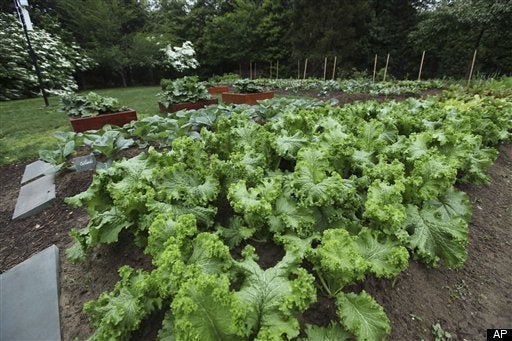
In my Earth Day blog I mentioned that 1.2 billion pounds of pesticides were sprayed per year in the United States with an annual cost of $11 billion, while the total world pesticide use exceeded 5.0 billion pounds in 2000 and 2001 (for a combined total of $64.5 billion). That should take care of all those nasty bugs! But, less than 0.01 percent of all those billions of pounds that are sprayed actually make it to the intended pest! Oops. Kind of surprising that such an inefficient system is still in use today, isn't it?
It probably wouldn't be so bad if the pesticides were only harmful to a few bugs, but they are not. All pesticides kill bugs by poisoning their nervous systems (think "brain" and "nerves"). Today the bulk of pesticides used are either organophosphates or pyrethroids. Organophosphates came out of nerve gas research in Germany between the first and second world wars. This is also the same class of compounds that was released into a Tokyo subway a number of years ago by a cult group. So, if you are concerned at all about your brain, your children's brains and the brains of our elected officials and everyone driving cars on the road around you, then maybe you want to help to start reducing the 99.99 percent of the 1.2 billion pounds of neurotoxic pesticides that are floating around because you decided to save a buck by buying a commercially raised apple.
While no pesticides or herbicides are used to grow crops that are certified organic, the idea that these crops are free of insecticide residue is actually not true. Those that are raised in open fields are open to the air and get contamination from pesticides and heavy metals that are blowing around. And these pesticides have been shown to fly around the globe, travelling thousands of miles. However, it is true that organically raised foods are significantly less contaminated with these chemicals than the same foods grown in non-organic methods (including integrated pest management systems). The levels of pesticide residue on foods in the United States is monitored through the Pesticide Data Program of the US Department of Agriculture. A review that utilized their data, along with data from Consumers Union and the Marketplace Surveillance Program of the California Department of Pesticide Regulation reported that organically raised foods had one-third the amount of chemical residues that were found in conventionally raised foods. When compared to those grown with integrated pest management techniques, the organics had half the amount of residues. In addition, organic foods were far less likely (by a factor of 10) to have two or more residues on them than conventional foods were. While only 2.6 percent of all organic foods had multiple residues detected, 26 percent of the conventional did. Data from the Pesticide Data Program revealed that the conventional produce that had the highest percentages of positive (insecticide residue) findings were: celery (96 percent), pears (95 percent), apples (94 percent), peaches (93 percent), strawberries (91 percent), oranges (85 percent), spinach (84 percent), potatoes (81 percent), grapes (78 percent) and cucumbers (74 percent) (45). That study found that an average of 82 percent of all conventional fruits were positive for insecticide residues while only 23 percent of the organics were. When it came to vegetables, 65 percent of the conventional tested positive, compared to only 23 percent for the organics.
The fruits and vegetables with the highest and lowest percentages of residues in the USDA study is very similar to the listing of the most and least toxic foods that is available on the web through Environmental Working Group. The current list given by them lists the top 12 most toxic fruits and vegetables as (In order of toxicity):
- Apple
- Bell Pepper
- Celery
- Nectarine
- Strawberries
- Cherries
- Kale
- Lettuce
- Grapes (Imported)
- Carrot
- Pear
And the least toxic ones as:
- Onion
- Avocado
- Sweet Corn
- Pineapple
- Mango
- Asparagus
- Sweet Peas
- Kiwi
- Cabbage
- Eggplant
- Papaya
- Watermelon
- Broccoli
- Tomato
- Sweet Potato
Not only have repeated studies shown that organic foods have lower levels of insecticides, but there is also now clear evidence showing lower pesticide levels in the actual consumers of the organic foods (i.e. You!). I also talked about these fascinating studies in Seattle (with Dr. Fenske at the University of Washington) in my Earth Day blog. It started with a simple study that looked at the organophosphate pesticide presence in the urine of preschoolers in the Seattle area. The researchers found that all but one child had pesticide residue in their urine (which meant it was in their bloodstream, as well). When they questioned the parents of this one child, they learned that they only fed organic food to their children.
So, the researchers began to plan another study to see if eating organic foods really did lower one's pesticides levels. Well, their follow-up study with preschoolers proved that it did. They enrolled families into the study by standing outside of the Puget Consumers Co-op (for families buying organic foods) and outside Larry's Market (for families buying conventional foods). When they broke the code on the samples they found that the children whose parents supplied them with mostly conventional foods had six to nine times higher levels of pesticides in their urine than the children who ate mostly organic foods. How nice to be able to take some simple steps that keep neurotoxic compounds from entering the bodies of our children and ourselves.